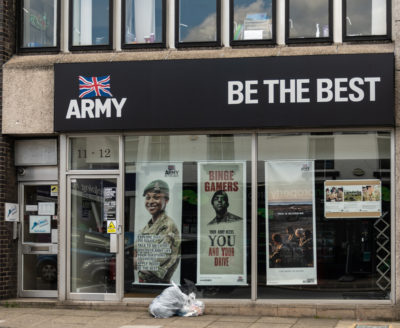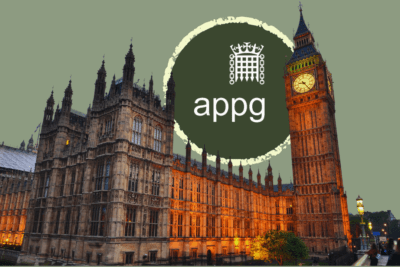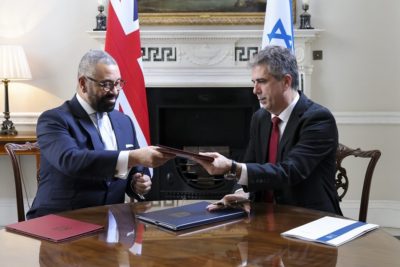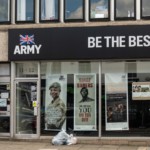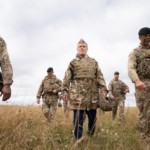The creep of militarism into our civil institutions
ForcesWatch comment
What national day is celebrated at the end of June in the UK? Many people may struggle to answer that as Armed Forces Day has only been established for 5 years but in 2014 there are over 200 public events “to Show Your Support for the men and women who make up the Armed Forces.” For many, it will go unnoticed unless you happen to come across a local parade or military-themed ‘family fun day’ in your town or city centre, but Armed Forces Day represents a major shift in military-civil relations over the last 6 or 7 years that has seen the embedding of the military in civilian institutions in a way never seen before. What will be the impact on how we, as a society, view and accept military activities and military approaches? How will the promotion of the military affect young people as the next generation of ‘future soldiers’?
This week has also seen Camo Day, established by a veterans’ charity to encourage school children across the country to “dress up like our troops” as a means to raise funds, and Uniform to Work Day, when reservists are encouraged to display their commitment to the services by wearing their armed forces uniform to their main job. The Armed Forces Day website states that, “UK Armed Forces defend the UK and its interests. They are busy working around the world, promoting peace, delivering aid, tackling drug smugglers and providing security and fighting terrorism.” Not only is this something of a rebranding or overlooking of the recent unpopular wars in Iraq and Afghanistan, but the public displays of support for the armed forces that it calls for also reinforce military activities and service as normal, desirable, and fun. Questions about why so many young men and women are killed or maimed or are in need of welfare are unlikely to be explored, as accompanying educational materials testify. As with the poppy appeal, which has become a corporate-led celebration of the military, these spectacles sell the armed forces as an unquestionable good and as a future career.
Institutionalising public support
These displays of support for the armed forces are a reflection of what the Quakers have called ‘a new tide of militarism‘, which can be tracked through a raft of new policy that is embedding ‘public support’ for the military within our civilian institutions – from the promotion of ‘military ethos’ in schools to the Armed Forces Community Covenant and Armed Forces Corporate Covenant, which aim to have every local authority and major business enlisted to support the armed forces and aid recruitment.
Armed Forces Day itself comes out of the Government report of 2008, National Recognition of our Armed Forces, which set out to establish a host of ‘countervailing measures’ to address a concern that support for the forces had been eroded by recent conflicts. The Armed Forces Covenant, recognised in law in 2011, sets out the ‘moral obligation’ between the armed forces, the government and the country. The Covenant talks of “honouring the commitment and sacrifice of the armed forces”, tackling disadvantage and isolation felt by the armed forces community, and “reflecting the nation’s respect”. In creating a framework for removing disadvantage in housing, healthcare, education, deployment and other areas, the government has also created a mechanism whereby local authorities, business, educational, charities and community organisations are morally obliged to honour the forces. The Armed Forces Community Covenant, while being a ‘voluntary statement’ of support, has been signed by almost every local authority in the UK. Covenants are signed by the council and often numerous partner agencies; the voluntary sector and other local organisations are then encouraged to show support. Many local authorities have appointed an ‘Armed Forces Champion’ or dedicated council officer to oversee services to that one community.
In 2013 the Chancellor gave £35m from the LIBOR funds to the Community Covenant grant scheme, at the same time that funding for other parts of the community is being cut. While removing disadvantage towards genuine equality is important, the Community Covenant goes much further by urging local authorities to build on wider support such as “fundraising, military celebrations and open days, attending homecoming parades and repatriation ceremonies and offering commercial discounts.” Many councils have cited the Covenant in their Armed Forces Day publicity. When asked by peace campaigners why Wrexham Council was reneging on its previous stance of not allowing military machinery in the public space, the local Armed Forces Champion stated that, “We have planned an event that has at its core the obligations of the Armed Forces Covenant… In addition to military displays, marches and entertainment there are also numerous veterans associations present that can and indeed do help the needs of ex-forces personnel and their families”. Wrexham’s Armed Forces Day, which took place on 21 June and was jointly funded by the Council, the Ministry of Defence and the Welsh Government, featured military vehicles and weapons, a military helicopter, an RAF simulator, and obstacle courses – all of which children could interact with. Its advertising featured a toddler in military uniform. The day itself had its own ambassador, a young veteran who, in a promotional video for the event, encourages young people to join the cadets and espouses the benefits of a military career.
A more recent addition to the Covenant family is the Armed Forces Corporate Covenants. It has so far been signed by over 100 companies including utilities, educational and financial institutions and charities, as well as parts of the defence industry. Companies are encouraged to offer “employment support for veterans, reservists, service spouses and partners, as well as support for cadet units, Armed Forces Day, and discounts for the armed forces community.” The Corporate Covenant will provide an important channel for reservists into the forces via their employers in support of the MoD’s Future Reserves policy, which seeks to significantly increase the proportion of reservists in relation to regular forces. The need to recruit high numbers of reservists has necessitated an extensive campaign to reach potential recruits wherever they may be found: the Army are already prominent in job centres and are providing training schemes for the long-term unemployed.
‘Military values’ have also been creeping into state education. While the armed forces have long had an occasional presence in schools, with around 11,000 visits made to schools and colleges each year for presentations and activities, military-led activities are now being promoted as part of national education policy. In 2012 the Department for Education announced a number of programmes under the ‘military ethos in schools’ umbrella. They have set aside large sums of money to expand cadet forces in state schools and fund military-based ‘alternative provision’ projects “to support pupils who are either disengaged with education or at risk of becoming disengaged”. The fast-tracking of ex-forces into schools under the ‘Troops to Teachers’ programme and the encouragement of academies and free schools “officially backed by the Armed Services and delivered by the Cadet Associations” within mainstream schooling are two further parts of the programme.
 ‘Military ethos in schools’ is justified on the grounds that it will raise educational attainment and tackle discipline in education and wider social dysfunction. The military-sponsored academies proposal was originally presented as a response to the 2011 riots. Yet it is questionable whether providing military activities for young people from disadvantaged communities is appropriate, particularly when there are concerns that these activities also serve as recruitment tools. While the MoD and cadet associations are at pains to deny that there is a recruitment link, otherofficial sources, including the MoD’sYouth Engagement Review, suggest that there is a strong recruitment purpose. The Review also states the importance of raising awareness of the military’s work in schools in order to “ensure the continued support of the population”. Recruiting the hearts and minds of the next generation is as important as recruiting the bodies of future soldiers.
‘Military ethos in schools’ is justified on the grounds that it will raise educational attainment and tackle discipline in education and wider social dysfunction. The military-sponsored academies proposal was originally presented as a response to the 2011 riots. Yet it is questionable whether providing military activities for young people from disadvantaged communities is appropriate, particularly when there are concerns that these activities also serve as recruitment tools. While the MoD and cadet associations are at pains to deny that there is a recruitment link, otherofficial sources, including the MoD’sYouth Engagement Review, suggest that there is a strong recruitment purpose. The Review also states the importance of raising awareness of the military’s work in schools in order to “ensure the continued support of the population”. Recruiting the hearts and minds of the next generation is as important as recruiting the bodies of future soldiers.
The battle for the narrative
The public relations offensive that has sought to change the relationship of the armed forces to civilian institutions is itself a response to a shift in public attitudes against armed responses to conflict. And, despite a high level of general support for individual servicemen and women, the young in particular areless likely to view the forces as important in serving Britain’s national interests. Concerned about how to sell themselves to a public increasingly sceptical of war and unwilling to be recruited, the armed forces are rethinking their public engagement, seeking to control the public narrative, and looking to strengthen their links with society yet further.
This process of adopting military values, priorities and solutions is often referred to as ‘militarisation’. This is not new to UK society of course and there is genuine public support for service men and women and concern for the welfare of them and their families. Policy-makers have, however, used this support to create a set of structural links between the military and social institutions that will be difficult to dismantle. The military and government have fought back against an unenthusiastic public to try and win back its appetite for military solutions and actions. Can that encouraging hostility to armed conflict hold out against widespread promotion of the military in every corner of our society?
In the face of ‘military normal’, as the American academic Catherine Lutz calls this prevalence of the military within everyday life, developing a widespread critical awareness of militarism and the agendas behind it is vital; we must continue to see the violence that militarism is founded on and not accept it as uncontroversial. Local campaigners opposed Wrexham Council’s spin on Armed Forces Day with letters to the council and local media and a highly visual ‘war is not family entertainment’ presence on the day itself. ForcesWatch is working to enable young people to voice their own concerns about the military’s ‘engagement’ with them and to reveal the recruitment agenda behind the cadet forces and other military activities. It is also campaigning with other organisations to raise the age of recruitment which, at 16 years old, is the lowest in the EU. That militarism is an ascendant force is reflected in growing academic study around it. Within education, teachers unions have spoken out about the armed forces recruitment activities and curriculum materials (recent visits to forces websites suggest that these materials are no longer being promoted) and raised concerns about aspects of introducing the ‘military ethos’ schemes into school. Interestingly, the DfE’s current scatter-gun approach to policy making is not necessarily producing results all round; it is unclear whether many ex-forces are successfully putting themselves forward as teachers and the only new military school to put itself forward so far, the Phoenix free school in Oldham, had its funding withdrawn earlier this year. Labour ministers’ enthusiasm for ‘service schools’ has, apparently, received little endorsement within the party.
Armed Forces Day falls on the day of the 100th anniversary of the assassination of Archduke Ferdinand and his wife in Sarejevo, the event that sparked the First World War. The disconnect between the horrors of that war, and the sadness of many of the lives that survived it, and the current culture of celebration around the military has never been greater. With support of the armed forces pervading every civic institution it becomes more difficult to make that connection. Events such as Armed Forces Day close down discussion around the realities of conflict. Presenting young people with military-led activities during or even instead of regular schooling or beguiling them with military hardware at community events or sending them from the job centre to army training courses, will inevitably channel some of the most vulnerable young people in our society into a high risk military career. They, and all of us, need to have the space and awareness to exercise a free and informed choice about joining up and about supporting the military’s way of doing things.
See more: military in society, recruitment, Armed Forces Day
Like what you read?
> Sign up for our newsletter or blog notifications
> Support our work – from just £2 a month

